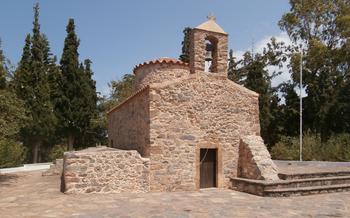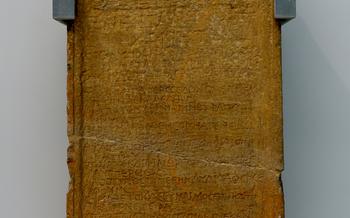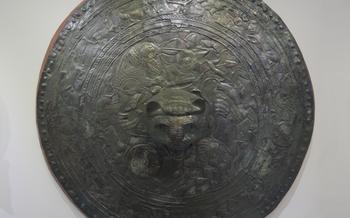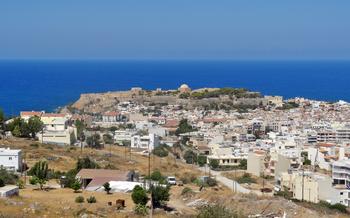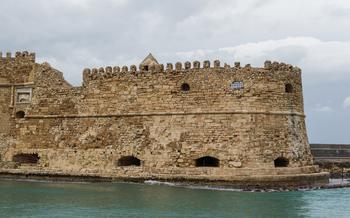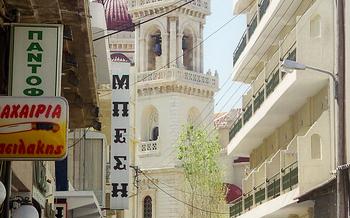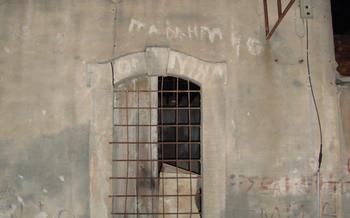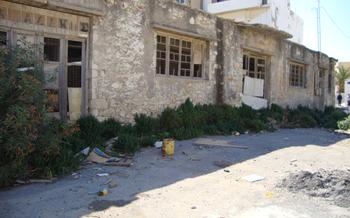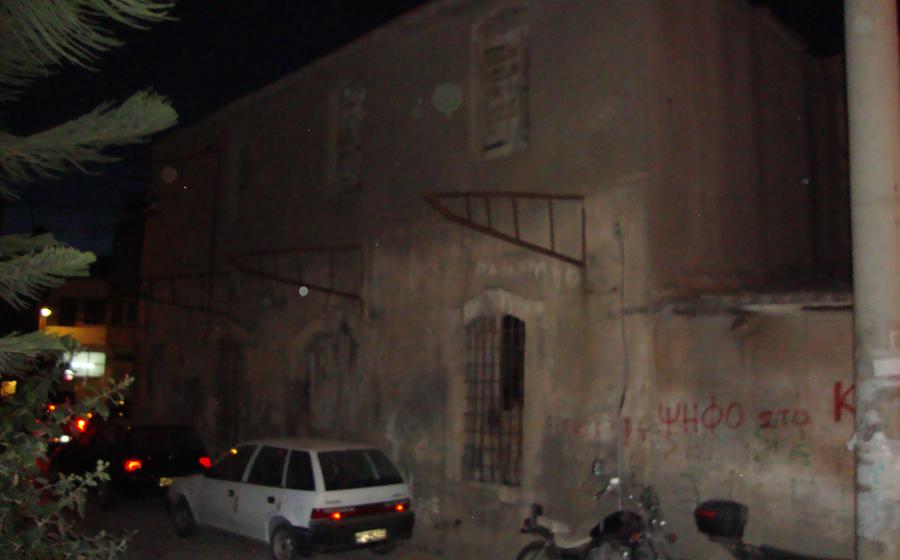
Lasithi Plateau
- Lasithi Plateau: A Unique Landscape in Crete
- Getting to the Lasithi Plateau
- Exploring the Traditional Villages
- The Windmills of Lasithi
- The Diktean Cave: A Realm of Myth and Legend
- The Lasithi Plateau Museum
- Hiking and Nature Trails
- Local Cuisine and Culinary Delights
- Festivals and Cultural Events
- Outdoor Activities and Adventure
- The Cave of Zeus
- The Monastery of Kera Kardiotissa
- The Village of Seli
- The Village of Anogeia
Lasithi Plateau: A Unique Landscape in Crete
Nestled in the heart of Crete, the Lasithi Plateau is a mesmerizing blend of natural wonders and cultural heritage. Perched at an altitude of over 800 meters above sea level, this fertile plain is surrounded by towering mountains, creating a breathtaking panorama that will leave you spellbound. The Lasithi Plateau is a true hidden gem of Crete, offering visitors a unique glimpse into the island's rich history, traditions, and stunning landscapes. Whether you're a nature enthusiast, a history buff, or simply seeking a tranquil escape, the Lasithi Plateau has something to offer everyone.
Why the Lasithi Plateau is worth a visit:
- Unique landscape: The Lasithi Plateau is home to a diverse range of landscapes, from lush valleys and rolling hills to towering mountains and secluded beaches.
- Cultural heritage: The plateau is dotted with traditional villages, ancient ruins, and historical landmarks, offering a glimpse into Crete's rich past.
- Outdoor activities: The Lasithi Plateau is a paradise for outdoor enthusiasts, with opportunities for hiking, cycling, horseback riding, and rock climbing.
- Local cuisine: The plateau is renowned for its delicious Cretan cuisine, featuring fresh, local ingredients and traditional recipes.
- Tranquility: The Lasithi Plateau offers a tranquil escape from the hustle and bustle of everyday life, allowing you to reconnect with nature and recharge your batteries.
What to expect from a trip to the Lasithi Plateau:
When visiting the Lasithi Plateau, you can expect to be surrounded by breathtaking scenery, warm hospitality, and a rich cultural heritage. The plateau is home to a variety of traditional villages, each with its own unique character and charm. You'll have the opportunity to explore ancient ruins, marvel at the iconic windmills, and discover hidden gems off the beaten path. Whether you choose to hike through the scenic landscapes, indulge in the local cuisine, or simply relax and soak up the tranquility, the Lasithi Plateau promises an unforgettable experience.
Tips for planning your visit:
To make the most of your trip to the Lasithi Plateau, here are a few tips to keep in mind:
- Choose the right time to visit: The best time to visit the Lasithi Plateau is during the shoulder seasons (May-June and September-October) when the weather is pleasant and there are fewer crowds.
- Explore the villages: Take the time to visit the traditional villages of the Lasithi Plateau, such as Kritsa, Agios Nikolaos, and Krasi, to experience the local culture and way of life.
- Don't miss the windmills: The windmills of Lasithi are a must-see attraction, offering stunning views of the plateau.
- Visit the Lasithi Plateau Museum: The museum provides insights into the history and culture of the region, with exhibits on traditional crafts, agriculture, and everyday life.
- Hike the Dikti Mountains: The Dikti Mountains, which surround the Lasithi Plateau, offer a variety of hiking trails for all levels of experience.
- Indulge in the local cuisine: Be sure to try the delicious Cretan dishes, such as dakos, moussaka, and gemista, made with fresh, local ingredients.
- Enjoy the festivals: The Lasithi Plateau hosts a number of festivals throughout the year, showcasing local traditions, music, and dance.
Getting to the Lasithi Plateau
Reaching the Lasithi Plateau is a breeze, offering various transportation options to suit your preferences and budget. For a scenic and flexible journey, renting a car is an excellent choice. The well-maintained roads and clear signage make driving a breeze, allowing you to explore the plateau at your own pace.
If you prefer public transportation, buses run regularly from Heraklion and Agios Nikolaos to the plateau. While less flexible, this option offers a budget-friendly way to get there.
For a hassle-free and informative experience, guided tours are available from major tourist hubs. These tours often include transportation, a knowledgeable guide, and stops at key attractions, ensuring you don't miss any highlights.
No matter your choice of transportation, start your exploration from Tzermiado, a picturesque village situated at the foot of the plateau. This central location provides easy access to all the plateau's wonders.
Exploring the Traditional Villages
The Lasithi Plateau is home to a number of charming traditional villages that offer a glimpse into the authentic Crete. These villages, with their whitewashed houses, narrow cobblestone streets, and friendly locals, are a delight to explore.
Kritsa is one of the largest and most popular villages in the plateau. It boasts a well-preserved historical center, a folklore museum, and several churches. Agios Nikolaos, located on the northern edge of the plateau, is a charming village with a beautiful lake and a picturesque harbor. Krasi is a small village famous for its lush vegetation, its Venetian fountain, and its traditional tavernas.
In these villages, visitors can experience the traditional Cretan way of life, which is centered around family, community, and agriculture. The locals are known for their hospitality and their love of music, dance, and food. Visitors can also find a variety of local crafts, products, and cuisine in these villages, including handmade woven goods, pottery, and traditional Cretan dishes such as dakos, gemista, and kalitsounia.
The Windmills of Lasithi
The Lasithi Plateau is home to a unique collection of windmills, which stand as a testament to the region's rich agricultural heritage. These iconic structures, with their distinctive white sails, once played a vital role in irrigating the plateau's fertile fields.
In the past, the windmills were used to pump water from underground aquifers to the surface, providing a reliable source of irrigation for the local farmers. The windmills operated on a simple yet effective principle: the wind would turn the sails, which would then rotate a series of gears connected to a pump. The pump would lift water from the aquifer and distribute it through a network of channels to the surrounding fields.
Today, the windmills of Lasithi are no longer used for irrigation purposes, but they remain a beloved symbol of the region's agricultural past. Many of the windmills have been restored and preserved, and they now serve as a popular tourist attraction. Visitors to the plateau can admire the windmills' unique architecture and learn about their historical significance.
The windmills of Lasithi offer a great opportunity for photography and scenic views. The windmills are particularly striking when they are silhouetted against the backdrop of the surrounding mountains or when they are bathed in the golden light of the sunset. Visitors can take a leisurely stroll among the windmills, capturing the beauty of these historic structures and the stunning landscapes that surround them.
The Diktean Cave: A Realm of Myth and Legend
The Lasithi Plateau is home to the renowned Diktean Cave, a site steeped in ancient mythology and religious significance. According to Greek legends, this cave served as the birthplace and sanctuary of Zeus, the king of the gods. It is believed that Zeus was raised in the cave by the nymphs Adrastea and Idaea, who protected him from his father, Cronus, who sought to devour him.
Archaeological excavations conducted within the cave have unearthed numerous artifacts and findings that corroborate its mythological associations. Discoveries include votive offerings, pottery fragments, and inscriptions dedicated to Zeus and other deities. These relics provide valuable insights into the religious practices and rituals that took place within the cave during ancient times.
Visitors to the Diktean Cave can embark on a captivating journey through its labyrinthine chambers and passages, marveling at the intricate stalactite and stalagmite formations that adorn its interior. The cave's mystical atmosphere and historical significance make it a must-see destination for anyone interested in Greek mythology and ancient history.
Practical Information:
-
Location: The Diktean Cave is situated on the eastern edge of the Lasithi Plateau, near the village of Psychro.
-
**
The Lasithi Plateau Museum
The Lasithi Plateau Museum is a treasure trove of historical and cultural artifacts that provide a fascinating glimpse into the region's rich past. Housed in a beautifully restored traditional building in the village of Tzermiado, the museum showcases a diverse collection of exhibits that bring the history and traditions of the Lasithi Plateau to life.
Visitors can embark on a journey through time as they explore the museum's galleries, each dedicated to a different aspect of the region's heritage. From ancient Minoan artifacts to Byzantine icons and traditional Cretan costumes, the museum offers a comprehensive overview of the cultural and historical influences that have shaped the Lasithi Plateau over the centuries.
Highlights of the museum's collection include intricate pottery and tools from the Minoan era, providing a glimpse into the lives of the island's earliest inhabitants. Medieval manuscripts and religious artifacts shed light on the Byzantine period, while traditional costumes and textiles showcase the region's rich artistic traditions.
The Lasithi Plateau Museum also features interactive exhibits and educational programs that bring history to life for visitors of all ages. Guided tours are available, providing visitors with in-depth insights into the region's past and the significance of the artifacts on display.
Whether you are a history buff, a culture enthusiast, or simply looking for a deeper understanding of the Lasithi Plateau, the Lasithi Plateau Museum is a must-visit destination. Its rich collection of artifacts and engaging exhibits offer a unique opportunity to delve into the heart of this captivating region's story.
Hiking and Nature Trails
The Lasithi Plateau is a hiker's paradise, offering a diverse range of trails that cater to all levels of experience. From gentle strolls through olive groves to challenging ascents up to the surrounding peaks, there's a trail to suit every taste.
One of the most popular hikes is the ascent to Mount Dikti, the highest peak on the plateau. The trail offers breathtaking views of the surrounding countryside, and on a clear day, you can even see as far as the island of Santorini. For a more leisurely walk, the trail around the Agios Nikolaos Lake is a great option. The trail takes you through a variety of habitats, including woodland, wetland, and scrubland, and offers plenty of opportunities to spot wildlife.
No matter which trail you choose, be sure to wear sturdy shoes and bring plenty of water, as there is little shade on the plateau. It's also a good idea to start your hike early in the morning or late in the afternoon to avoid the heat of the midday sun.
Local Cuisine and Culinary Delights
The Lasithi Plateau is a culinary haven, offering a diverse range of traditional Cretan dishes that showcase the region's fresh, local ingredients and authentic flavors. From mouthwatering grilled meats to savory pies and fresh seafood, the plateau's cuisine is a delightful blend of traditional recipes and contemporary culinary innovations.
Must-try dishes include the hearty "antikristo" lamb, slow-cooked over an open fire, and the succulent "dakos" salad, made with barley rusks, tomatoes, feta cheese, and olives. For a taste of the sea, try the freshly caught fish or the "kalitsounia," fried pastries filled with cheese and herbs. Vegetarians will delight in the variety of fresh vegetables, legumes, and greens, often served with a drizzle of local olive oil and a sprinkle of aromatic herbs.
To fully immerse yourself in the local culinary scene, visit one of the many traditional tavernas or restaurants scattered throughout the plateau. These charming establishments offer a warm and welcoming atmosphere, where you can savor delicious home-cooked meals and engage with the friendly locals.
For those who want to delve deeper into the culinary traditions of the region, cooking classes and culinary experiences are available. Learn the secrets of Cretan cuisine from local chefs and immerse yourself in the vibrant flavors and aromas of this culinary paradise.
Festivals and Cultural Events
The Lasithi Plateau comes alive during its annual festivals and cultural events, showcasing the region's rich traditions and heritage. These celebrations provide a glimpse into the local way of life and offer visitors a chance to immerse themselves in the vibrant Cretan culture.
The most notable festival is the Lasithi Plateau Festival, held in August. This grand celebration features traditional music and dance performances, culinary delights, and exhibitions of local crafts and products. Visitors can witness the Cretan "Pentozali", a unique dance performed by five men balancing on their shoulders a wooden construction decorated with colorful ribbons and bells.
Other festivals include the Wine Festival in September, celebrating the region's viticulture and offering tastings of local wines paired with traditional Cretan dishes. The Olive Festival in November highlights the importance of olive cultivation, with demonstrations of olive pressing and sampling of fresh olive oil.
Participating in these festivals is a fantastic way to connect with the locals, experience the authentic Cretan spirit, and create lasting memories of your visit to the Lasithi Plateau.
Outdoor Activities and Adventure
The Lasithi Plateau offers a diverse range of outdoor activities and adventure opportunities for those seeking an adrenaline rush or a chance to connect with nature. Mountain biking enthusiasts can explore the numerous trails that wind through the plateau's rugged terrain, providing breathtaking views as they cycle through olive groves and traditional villages.
Horseback riding excursions are another popular way to experience the beauty of the region, with guided tours that allow riders to traverse scenic trails and immerse themselves in the tranquility of the natural surroundings. For those seeking a more challenging adventure, rock climbing and rappelling opportunities are available on the steep cliffs that dot the plateau's landscape.
Jeep safaris and off-road adventures are perfect for exploring the hidden corners of the plateau, with guided tours that take participants on thrilling rides through rugged terrain, offering the chance to discover secluded spots and enjoy panoramic views.
The Cave of Zeus
According to Greek mythology, the Cave of Zeus was the birthplace of the almighty god Zeus, the king of the gods and ruler of Mount Olympus. Located on the Lasithi Plateau, the cave holds a significant place in Greek mythology and has been a site of religious worship since ancient times.
The cave is nestled amidst towering cliffs and rugged mountains, creating a mystical and awe-inspiring setting. Visitors can explore the cave's various chambers and passageways, marveling at the intricate rock formations and stalactites.
Archaeological evidence suggests that the cave was used as a place of worship in the Minoan era, and later in the Roman period. Ancient artifacts, including pottery, tools, and religious offerings, have been discovered within the cave, providing a glimpse into the rituals and beliefs of past civilizations.
Today, the Cave of Zeus remains a popular destination for pilgrims and tourists alike. Visitors can explore the cave on guided tours, learning about its mythological significance and the archaeological discoveries made within its depths. The cave's stunning natural beauty and historical importance make it a must-visit for anyone interested in Greek mythology and ancient history.
The Monastery of Kera Kardiotissa
Nestled amidst the picturesque landscapes of the Lasithi Plateau, the Monastery of Kera Kardiotissa stands as a testament to the region's rich religious history. Founded in the 14th century, the monastery has undergone several renovations and expansions over the centuries, resulting in a harmonious blend of architectural styles. Its whitewashed walls and intricate stonework exude an aura of serenity, inviting visitors to immerse themselves in the spiritual ambiance of this sacred site.
The monastery's interior is adorned with stunning frescoes and icons, each narrating a chapter from the Bible or depicting scenes from the lives of saints. The intricate craftsmanship and vibrant colors transport visitors back in time, offering a glimpse into the artistic and cultural heritage of the region. The monastery's church is a particularly awe-inspiring sight, with its grand dome and ornate altar, creating a sense of reverence and devotion.
Beyond its religious significance, the Monastery of Kera Kardiotissa offers breathtaking views of the surrounding countryside. Perched on a hilltop, the monastery provides a panoramic vista of the Lasithi Plateau, with its lush green fields, traditional villages, and distant mountain ranges. Visitors can wander through the monastery's peaceful gardens, adorned with fragrant flowers and shady trees, while enjoying the tranquil atmosphere and the panoramic views.
For those seeking a deeper connection with the monastery's spiritual heritage, guided tours are available, providing insights into the history, traditions, and daily life of the monks. Visitors are encouraged to observe the monks' daily routines, such as prayers, chanting, and work, gaining a firsthand understanding of the monastic lifestyle.
Whether seeking spiritual enlightenment, admiring architectural beauty, or simply relishing the serene atmosphere, the Monastery of Kera Kardiotissa is a must-visit destination in the Lasithi Plateau. Its unique blend of history, art, and natural beauty offers an unforgettable experience for visitors of all faiths and backgrounds.
The Village of Seli
Nestled amidst the foothills of the Lasithi Plateau, the picturesque village of Seli beckons travelers with its timeless charm and traditional Cretan character. Cobblestone streets wind their way through the village, leading to whitewashed houses adorned with colorful flowers and intricate stone carvings.
Seli's history is deeply intertwined with the land and its people. For centuries, the village has been a center of agricultural activity, with its fertile soil and abundant water resources supporting a thriving community of farmers and shepherds. This rich agricultural heritage is reflected in the village's architecture, with many of the homes featuring outdoor ovens and courtyards used for drying fruits and vegetables.
In recent years, Seli has emerged as a popular tourist destination, attracting visitors with its authentic Cretan experiences and stunning natural surroundings. The village is home to several traditional tavernas, where visitors can savor delicious local cuisine prepared with fresh, seasonal ingredients. Visitors can also explore the village's many shops, which offer a variety of handcrafted souvenirs, including ceramics, woven textiles, and leather goods.
For those seeking a deeper connection with nature, Seli offers a range of hiking trails that wind through the surrounding countryside, providing breathtaking views of the Lasithi Plateau and the Dikti Mountains. The village is also a popular starting point for excursions to the nearby beaches, where visitors can swim, sunbathe, and enjoy the crystal-clear waters of the Mediterranean Sea.
The Village of Anogeia
Nestled in the heart of the Lasithi Plateau, the village of Anogeia stands out for its rich cultural heritage and vibrant traditions. Known as the cradle of Cretan music and dance, Anogeia has played a pivotal role in preserving and promoting the island's unique artistic expressions.
Visitors to Anogeia are immediately captivated by the village's charming atmosphere, characterized by narrow, winding streets, traditional stone houses, and the ubiquitous sound of lyres and laoutos filling the air. The village is home to a thriving community of musicians, dancers, and artisans who keep the spirit of Crete alive through their performances and creations.
In Anogeia, you can witness the Cretan dance in its purest form, performed by skilled dancers wearing traditional costumes. The village is also renowned for its skilled craftsmen, who create intricate leatherwork, textiles, and jewelry using techniques passed down through generations.
Whether you're attending a traditional music and dance performance, exploring the village's artisan workshops, or simply strolling through its picturesque streets, Anogeia offers an immersive experience of Cretan culture and hospitality.
